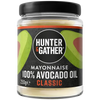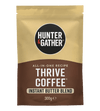I think the clue is in our name – we are all about living and eating more like our ancestors here at Hunter & Gather and this guest blog by the wonderful Sara Aguilar sums up some of the interesting differences between a day in the life of our ancestors and a modern-day life for us humans. But don’t worry there are also some handy tips on how you can adopt some ancestral hacks into your modern life too.
The demands of our modern lifestyles harshly contradict our natural physiologies; physiologies that are very similar to that of our ancestors. We have not physically evolved, while the world around us transforms at the speed of light.
Did you know that it takes us 40,000 to 100,000 years to physiologically adapt to changes in our diet and environment?[1]
How can our minds and bodies cope with the onslaught of crippling industrial era inspired work schedules, anti-nutrient foods and energy depleting EMFs (Electric Magnetic Fields)?
Would our ancestors recognise the world we live in?
We live in a world our hunter gather ancestors would not recognise. We eat calorie dense, nutrient deficient processed foods, we no longer rise with the sun and we hardly move, opting instead for sedentary living and the comforts of convenience.
Is it any wonder that ‘sick, tired, fat and chronically inflamed’ are the pervasive status quo for the majority of people today?
The problem is that convenience, comfort, efficiency and cost have taken precedence over quality of life. Our values have changed and enriching communities, movement and play, as well as seasonal, nutrient replete foods have been diminished.
Diseases of Civilisation
The consequences have manifested in chronic illnesses which now plague the modern human. These chronic illnesses are the ‘diseases of civilisation’ and include type 2 Diabetes, Alzheimer’s, Parkinson’s, ADHD, Hypothyroidism, obesity, chronic stress and mental health issues.
Sounds like a far cry? Well, if you consider how our ancestors lived in comparison to us, the picture begins to make a little more sense.
Day in the Life of an Ancestral Human
Wake up with the sun after a restorative sleep, immediately steps outside onto the ground—grounding—and they are exposed to sunlight and fresh air. Their day would revolve around contributing to their community with a typical “workday” of three to four hours, including procurement of food, housing and clothing”.[2]
Food would include seasonally foraged berries and wild greens, as well as seasonally hunted wild pastured game and wild fish. Exposing them to a dynamic biodiversity of bacteria, nutrients, polyphenols, fats, proteins and limited fructose. They consumed organ meats and fats from pastured animals and a healthy dose of Omega 3 fatty acids EPA and DHA from wild fish.
Throughout the day, they would be engaged in continuous low-level activity, with a few bursts of high intensity sprints throughout the week, required for hunting prey and fleeing predators. Socialising, play, storytelling and communal eating would fill the remainder of their time and these were highly valued activities.[3]
Everything in nature is ‘Feast or Famine’[4] and our bodies have been designed to work for food and endure hunger.
Our hunter gatherer ancestors tended to eat during the daytime—not after dark—while they were safer from nocturnal predators. Eating twice, sometimes just once a day. Intermittent fasting was the norm—which gave their bodies plenty of opportunities for cellular regeneration and cleansing (autophagy).
Evening would close around a bonfire and storytelling and after dark, our hunter gather ancestors would retreat to their rudimentary but adequate homes. Basic needs of food, shelter, community met. The cool night air, pitch darkness and the hum of crickets soothe them into a deep regenerative sleep.
Day in the Life of a Modern Human
Our modern human is abruptly awoken by their blaring alarm after a poor night’s sleep—since they ate a high carb dinner late and then stayed up late on their smart phone in bed the night before—and were exposed to EMF, blue light, a warm room and city noises throughout the night.
The perfect concoction for a poor night’s sleep.
Why? Because high carb foods encourage an increased insulin release—insulin is the hormone which lowers blood sugar levels and shuttles sugar and fat around the body to be deposited or utilised where needed. Insulin inhibits Melatonin—melatonin is our sleep hormone. In addition, when we eat late at night our bodies prioritise processing our foods at the expense of detoxing and regeneration. ‘Beauty Sleep’ is real but it’s not just for the body—it’s also for the mind.[5]
Blue light also tells our bodies that it is daytime which further suppresses melatonin. Late evening and night exposure to blue light tells our bodies that it is daytime and that we need to be awake. Using electrical technology at night disrupts our sleep because of the blue light they emit and the stimulation from the social media/dopamine addiction, etc.
Once awake, we’re stressed about being late for work, firing cortisol and adrenaline, whilst we’re still tired. Instead of hydrating with water, we make coffee—which releases even more cortisol and adrenalin to help us ‘wake up’ whilst simultaneously dehydrating us.
For breakfast our modern human tends to eat some form of processed carbohydrate—‘heart healthy’ cereal, muesli, gluten rich toast, spread with degraded vegetable fat spread, with a glass of fructose laden orange juice—literally mainlining sugar and degraded fats. A concoction for inflammation, oxidation and glycation and that’s just at breakfast! Don’t be fooled by fruit and fruit juices—the fructose still spikes blood sugar levels!
They commence a stressful journey to work while the instant ‘hit’ of sugar feels good but the consequent increase in insulin knocks down blood sugar levels, triggering ghrelin (the hunger hormone) which means that they are hungry by mid-morning—that ‘Elevenses’ which you never need on a high fat, low carb diet. They’ll feel tired again with the sugar crash and grab a sugary, hormone and antibiotic laden milky coffee and a muffin made with processed seed oils. To stay awake, they’ll need another coffee ‘pick me up’ at 5 or 6pm. Again, more carbs, processed sugars and degraded vegetable fats— while sedentary at a desk for at least 8 hours.
The sugars, degraded fats and cortisol sit in the system having free radical fun, causing oxidative and inflammatory damage. Yet, this is the diet touted as ‘heart healthy’. It’s purely a straight up recipe for diabetes, heart disease, obesity and neurological degradation.
Killer Calories
Where are the animal fats and protein? Where is the biodiversity of micronutrients? These aren’t just empty calories; the situation is far more sinister: they are killer calories…literally!
The day continues as such and if this modern human is health conscious they might head to the gym for an hour of intense exercise after work—but since they’ve been sedentary all day and hunched over—as well as exposed to artificial light and EMF all day—their lack of mobility and dysfunctional movement can easily lead to injury.
They get home late, if they are lucky they have family or friends to eat with. If not, they eat alone or late in front of the tv, restarting the cycle of disrupted sleep to begin another day, on the tired hamster wheel.
The modern human has their basic needs ‘met’ but are lacking the substance and purpose of hunter gatherer living: the nourishing community, food and movement.
Our modern lives don’t nourish us, they deplete us.
How do we bridge the gap between our modern environment and our ancestral physiologies?
Can we simulate a natural environment that supports a natural physiology in such an unnatural world?
The good news is: Yes. We. Can.
Thanks to technology, science, biohacking and ancestral anthropology we know exactly what we need to do to cultivate health. Modern advances aren’t all bad—we need to select the advances that benefit us and discard the ones that don’t. We have the knowledge, resources and ability to live healthier lives than our ancestors.
Sleep and Environment
Protect your sleep. Sleep is fundamental as it is the one thing we die quicker without—after oxygen.
Light & Sound
Avoid blue light at night to increase melanin and melatonin production. You can easily do this by using a blue light filter on your phone, using blue light blocking glasses or just avoiding tv and phone light at night—spend time socialising instead in candlelight.
Wear an eye mask and if it’s very noisy, wear ear plugs.
Create a morning routine of getting out in the sunlight and fresh air on waking and standing on the ground—this will stimulate a healthy circadian rhythm.
Temperature
Stay cool at night. Lower your thermostat or have a window open.
Electricity
Avoid having electrical equipment in the bedroom—the bedroom is for two things only—leave your phone in another room and switch it off or on airplane mode at night.
Himalayan salt lamps have been shown to neutralise EMF. They give off a soothing glow too—simulating a dusk light.
Nutrition
A basic rule of food is…would our ancestors have recognised it as a food?
Yes or No?
If you answer this question, you know if you’re eating ancestrally or not. Food should look like the animal or plant that it is. Eating healthily is really simple. If there is lots of marketing or unrecognisable ingredients on the packaging—this is a clear indicator that it is not real food.
Our ancestors would have eaten a high fat, low carb diet most of the time—with the exception of communities from near the equator. Even so, their fruits were not genetically modified to be super sweet—the fruit they ate was much tarter and more fibrous than what we find in supermarkets today.
Wild caught fish and pastured animals have a favourable omega-3 to omega-6 ratio and are far more nutrient dense than factory farmed animals. Have you ever compared an organic, free range egg yolk to factory farmed egg yolk? The truth is in the yellow! The free range egg will be a much deeper sunset yellow—and far tastier too—in contrast to the sad pale yellow egg yolk of the factory farmed chicken.
Leafy green vegetables are micronutrient, mineral and vitamin dense—choose organic if your budget allows and if you can eat locally sourced produce, even better.
Focus on eating animal fats, such as butter, ghee, tallow and lard, as well as non-processed plant fats such as avocado and coconut oil.
Timing of eating is also important as our ancestors ate during daylight hours but within a restricted time window. Try intermittent fasting or at least a 12 hour fasting period and avoid eating 3 hours before bed…you may find that you sleep better and lose weight even if eating the same number of calories.[6]
Movement

If you do have an office based, sedentary job, see if you can incorporate more movement into your day by walking to speak to colleagues, instead of e-mailing and taking the stairs instead of the lift.
Suggest ‘walking’ meetings, take telephone calls while standing up or walking and get a standing desk. You could perhaps even go to the gym or for a brisk walk at lunchtime to break your day up with movement.
We supposedly live in an abundant world, but actually we live in lack.
We need to look to our ancestors for guidance on how to eat, sleep and move. Incorporate just a few changes into your life, adding in more healthy fats, protecting your sleep, moving throughout the day and socialising—and you’ll quickly find that you have more energy, vitality and health.
A final word of warning from Nora Gedgaudas:
‘Our future as a species essentially lies in our past. Adopting a dietary approach that is consistent with our foundational primitive physiological requirements is the first step in restoring our health. It may well be the underlying key to our very survival.’[7]
Blog post written for Hunter & Gather by Sara Aguilar, MSc Anthropologist, Sports Nutritionist & Supplements Advisor Founder of Keto Supplements and Co-Founder of LIV NRG “Passionate about fitness, nutrition and ancestral living; Sara set up Keto Supplements to source supplements and products to alleviate her husband’s epilepsy. Keto Supplements is now the leading Ketogenic Food Supplement site in Europe.”
All information provided on our website and within our articles is simply information, opinion, anecdotal thoughts and experiences to provide you with the tools to thrive.
It is not intended to treat or diagnose symptoms and is definitely not intended to be misconstrued for medical advice. We always advise you seek the advice of a trained professional when implementing any changes to your lifestyle and dietary habits.
We do however recommend seeking the services of a trained professional who questions the conventional wisdom to enable you to become the best version of yourself.
[1] Nora Gedgaudas, Primal Body, Primal Mind
[2] Nora Gedgaudas, Primal Body, Primal Mind
[3] Yuval Harari, Sapiens
[4] Robb Wolf, Wired to Eat
[5] Matthew Walker, Why We Sleep
[6] Sachin Panda, The Circadian Code
[7] Nora Gedgaudas, Primal Body Primal Mind p. 296




















